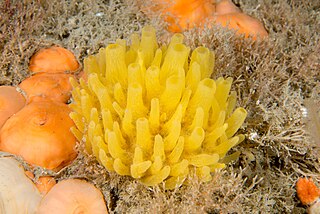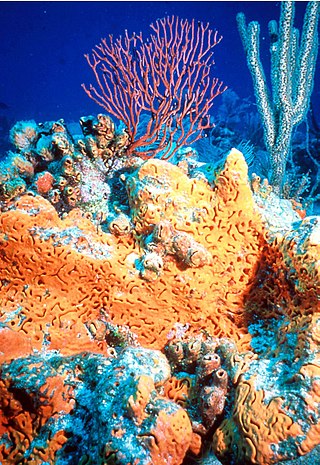
Cladorhiza is a genus of carnivorous sponges, comprising around 40 species found in oceans around the world. Cladorhiza is the type genus of the family Cladorhizidae.

Polymastia is a genus of sea sponges containing about 30 species. These are small to large encrusting or dome-shaped sponges with a smooth surface having many teat-shaped projections (papillae). In areas of strong wave action, this genus does not grow the teat structures, but instead grows in a corrugated form.

Chondrocladia is a genus of carnivorous demosponges of the family Cladorhizidae. Neocladia was long considered a junior synonym, but has recently become accepted as a distinct genus.

Agelas is a genus of sea sponge in the class Demospongiae.
Cladorhiza caillieti is a carnivorous sponge of the family Cladorhizidae described in 2014 from specimens collected from the Juan de Fuca Ridge off the coast of Vancouver Island. It feeds on small crustaceans such as amphipods and copepods. C. caillieti is an elongate, bottlebrush-shaped sponge with filaments projecting from a main stem, and ranges from 7 to 9 cm in height. The specific epithet honors Dr. Gregor M. Cailliet of the Moss Landing Marine Laboratories.
Axoniderma is a genus of carnivorous demosponges in the family Cladorhizidae.
Jean Vacelet is a French marine biologist who specialises in the underwater fauna of the Mediterranean. After earning his licence at the Faculté des Sciences de Marseille and learning to dive in 1954, he specialised in the study of sponges at the Marine station of Endoume, and there he has stayed faithful to both sponges and place for more than half a century. His research has included all aspects of sponges: taxonomy, habitat, biology, anatomy, their bacterial associations, and their place in the evolution of multi-celled animals. He has studied them not only in the Mediterranean but in the Indian Ocean and the Pacific. Exploration of underwater grottoes, together with Jacques Laborel and Jo Hamelin, revealed the existence of sponges dating from very ancient geological periods and the unexpected existence of carnivorous sponges, and surprisingly, the grottoes in some ways mimicked life at much greater depths.
Michelle Kelly, also known as Michelle Kelly-Borges, is a New Zealand scientist who specialises in sponges, their chemistry, their evolution, taxonomy, systematics, and ecology.
Euplectella gibbsa is a species of glass sponge in the family Euplectellidae. It has been found in the North Atlantic Ocean.
Euplectella paratetractina is a species of glass sponge in the family Euplectellidae. It has been found in waters off the coast of Australia.
Euplectella sanctipauli is a species of glass sponge in the family Euplectellidae. It is known from type specimens found off the coast of Brazil.
Axoniderma australis is a species of demosponge in the family Cladorhizidae. It is known from type specimens found off the coasts of Tasmania and New South Wales.
Axoniderma poritea is a species of demosponge in the family Cladorhizidae. It is known from type specimens found on the east coast of Australia.
Axoniderma hubbsi is a species of demosponge in the family Cladorhizidae. It is known from type specimens found in the northeast Pacific Ocean.
Axoniderma kensmithi is a species of demosponge in the family Cladorhizidae. It is known from type specimens found in the Pacific Ocean off the coast of California.
Axoniderma mexicana is a species of demosponge in the family Cladorhizidae. It is known from type specimens found around Mexico.
Caulophacus brandti is a species of glass sponges belonging to the subfamily Lanuginellinae. It is known from type specimens found in the Weddell Sea. The specific epithet was given in honor of Angelika Brandt.
Caulophacus discohexactinus is a species of glass sponges belonging to the subfamily Lanuginellinae. It is known from a type specimen found in the Weddell Sea. The specific epithet was given to refer to the discohexactine shape of the species' microscleres.
Caulophacus weddelli is a species of glass sponges belonging to the subfamily Lanuginellinae. It is the only species in the subgenus Oxydiscus. It is known from a type specimen found in the Weddell Sea, which lends its name to the specific epithet weddelli.



